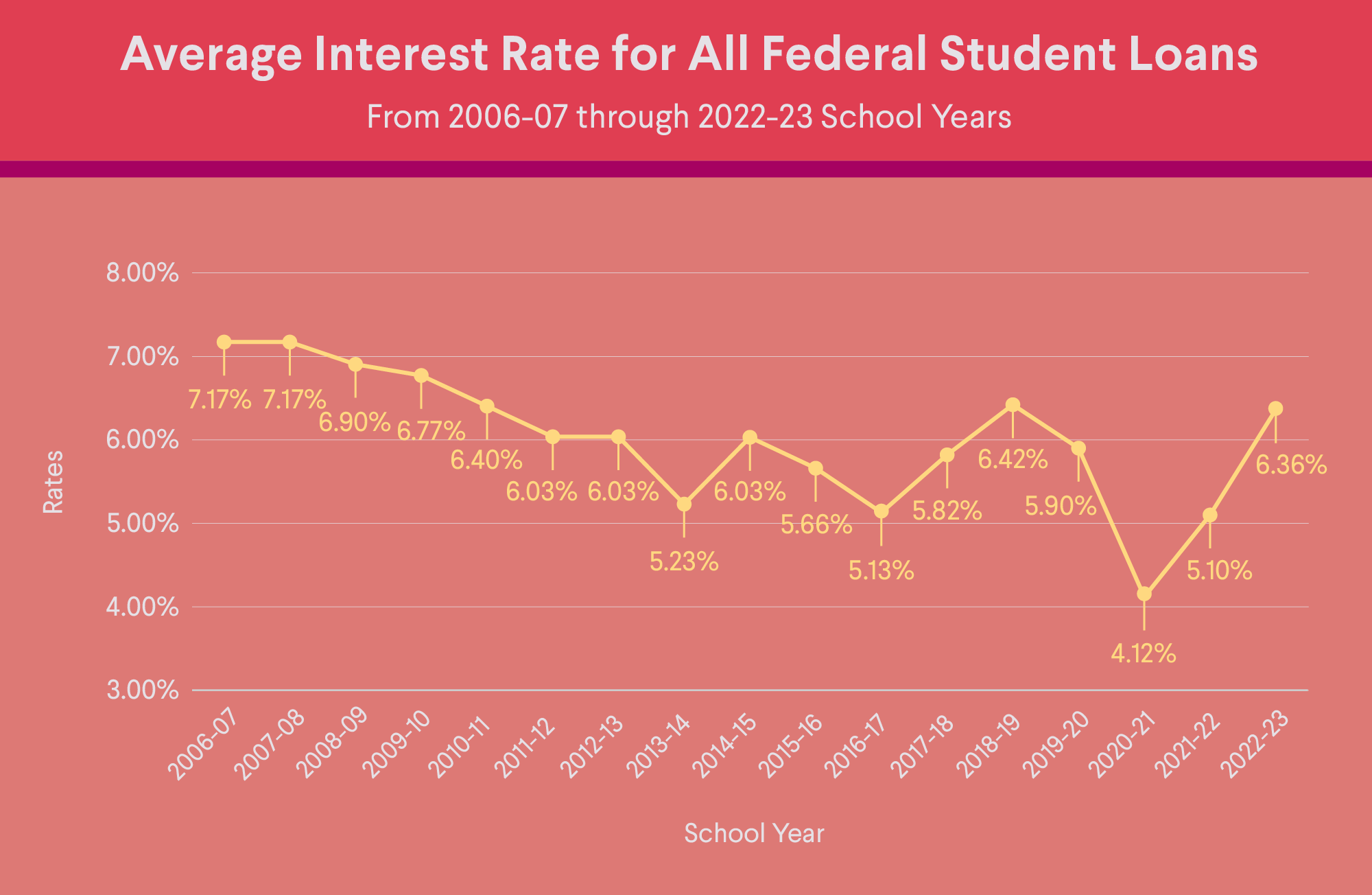What’s the Average Student Loan Interest Rate?
Student loans, like any loans, have an interest rate (and, sometimes, other loan fees). While interest rate accrual on existing federal student loans was paused from March 2020 through August 2023 due to the Covid-19 forbearance, the 2023 debt ceiling bill officially ended the payment pause, requiring interest accrual to resume on Sept. 1 and payments to resume in October 2023. And of course, any new student loans — federal or private — will have an interest rate that impacts the total cost of the loan.
So what is the average student loan rate? While it would be difficult to nail down the average rate of all active student loans held by borrowers, we know the interest rates of new federal student loans, as well as the range of rates for private student loans.
Table of Contents
- What Is The Average Student Loan Interest Rate?
- How Is Student Loan Interest Calculated?
- What to Look For In a Student Loan Interest Rate
- Average Interest Rates for Student Loans FAQ
- What Is a Good Fixed Interest Rate for Student Loans?
- Is 30K In Student Loans Bad?
- Is a 4.75% Interest Rate Good?
- How Can I Reduce the Interest Rates on my Student Loans?
What Is The Average Student Loan Interest Rate?
The interest rate on a student loan varies based on the type of student loan. Federal student loans issued after July 1, 2006, have a fixed interest rate. The rates on newly disbursed federal student loans are determined annually by fixed formulas specified in the Higher Education Act of 1965 (HEA).
These are the federal student loan interest rates for the 2023–24 school year:
• 5.50% for Direct Subsidized or Unsubsidized loans for undergraduates
• 7.05% for Direct Unsubsidized loans for graduate and professional students
• 8.05% for Direct PLUS loans for graduate students, professional students, and parents
All three of those rates have risen from the 2022-2023 school year, and the undergraduate rate has doubled since the 2020-2021 school year.

Source: Studentaid.gov
This means that the average rate for the three main types of federal student loans is 6.87%:

Source: Studentaid.gov
Private student loan interest rates vary by lender and each has its own criteria for which rates you qualify for. Private student loans can have either fixed interest rates that remain the same over the life of the loan or variable rates that can start lower than a fixed interest rate but then go up over time, based on market changes.
Private lenders may also offer different interest rates if you have a cosigner on your student loan. The interest rates on private student loans can vary anywhere from 4% to 17%, depending on the lender, the type of loan, and on individual financial factors including the borrower’s credit history.
Recommended: Types of Federal Student Loans
How Are Interest Rates Determined?
As mentioned previously, the interest rates on federal student loans are set annually by fixed formulas specified in the HEA. The rates are tied to the financial markets — federal law sets them based on the 10-year Treasury note and a statutory add-on percentage with a maximum rate cap.
Since July 2006, all federal student loans have fixed interest rates. Although federal student loans are serviced by private companies or nonprofits selected by the federal government, these loan servicers have no say in the federal interest rate offered.
For private student loans, the lenders set their own rates, though they often take cues from federal rates. Each lender has their own algorithm and credit standards. The rates quoted for student loans vary based on each applicant’s individual situation — though generally the better a potential borrower’s financial history is, the better rate they may be able to qualify for.
To learn more about private and federal student loans check out our student loan help center. If you’re looking to reduce your interest rate, student loan refinancing may be right for you.
💡 Quick Tip: Ready to refinance your student loan? With SoFi’s no-fee loans, you could save thousands.
How Is Student Loan Interest Calculated?
After a three-year payment pause, the debt ceiling bill officially ended the Covid-19 forbearance, requiring federal student loan interest accrual to resume on Sept. 1 and payments to resume in October 2023.
Interest on federal student loans typically accrues daily. To calculate the interest as it accrues, the following formula can be used:
| Interest amount = (outstanding principal student loan balance × interest rate factor) × days since last payment |
In other words, you will multiply your outstanding loan balance by the interest rate factor. Then, multiply that result by the days since you last made a payment.
To calculate that interest rate factor you can divide the interest rate by the number of days of the year (365). For example, let’s say you have an outstanding student loan balance of $10,000, an interest rate of 4.75%, and it’s been 30 days since your last payment. Here’s how to calculate your interest:
| $10,000 x (4.75%/365) = $1.30 daily interest charge |
| $1.30 x 30 days = $39 |
| Interest amount $39 |
Many private student loans will also accrue interest on a daily basis, however, the terms will ultimately be determined by the lender. Review the lending agreement to confirm.
Recommended: When Do Student Loans Start Accruing Interest?
What to Look for in a Student Loan Interest Rate
When you take out a federal student loan, you’ll receive a fixed interest rate. This means that you’ll pay a set amount for the term of the student loan. In addition, all of the terms, conditions, and benefits are determined by the government. Federal student loans also provide some additional perks that you may not find with private lenders like income-driven repayment (IDR) plans.
The Saving on a Valuable Education (SAVE) Plan is one of the IDR options to consider if you’re a federal student loan borrower. The SAVE Plan is the most affordable repayment plan for federal student loans, according to the U.S. Department of Education. Borrowers who are single and make less than $32,800 a year won’t have to make any payments under the SAVE Plan. (If you are a family of four and make less than $67,500 annually, you also won’t have to make payments.)
Private student loans can have higher interest rates and potentially fewer perks than federal student loans. You may want to take advantage of all federal student loans you qualify for before comparing private loan options.
Average Interest Rates for Student Loans FAQ
Here are some common questions about the average interest rates of student loans:
What Is a Good Fixed Interest Rate for Student Loans?
When it comes to cost, the lower the interest rate, the better. The lower the interest rate, the less a borrower will owe over the life of the loan, which could help individuals as they work on other financial goals. If you’re taking out federal loans, the student loan interest rate is set by federal law, so you don’t have a choice for what is and isn’t a reasonable interest rate.
When it comes to private student loans, it’s wise to shop around and compare your options to find the most suitable financing solution. Since every lender offers different terms, rates, and fees, getting quotes from multiple lenders may help you select the best option for your personal needs. Keep in mind that the rate you receive on a private student loan is largely dependent on your credit score and other factors, whereas federal student loan interest rates are based on HEA formulas and not your creditworthiness.
Also keep in mind that private student loans do not have the same borrower protections as federal student loans, including IDR plans or deferment options, and should be considered only after all federal aid options have been exhausted.
Is $30K In Student Loans Bad?
If you owe $30,000 in student debt, you’re right in line with the national average. More than 40 million consumers have outstanding student debt as of 2023, and the average borrower owes about $35K, according to TransUnion®.
Is a 4.75% Interest Rate Good?
With interest rates on private student loans ranging anywhere between 4% and 17%, and the three types of federal student loan rates averaging 6.87% for the 2023-2024 school year, a 4.75% interest rate in 2023 is lower than what most students can get on a new student loan.
How Can I Reduce the Interest Rates on my Student Loans?
The interest rate on federal student loans, while fixed annually for the life of the loan, does fluctuate over time. For example, the rates for Direct Subsidized and Unsubsidized loans for undergraduates doubled from 2.75% in 2020–21 to 5.50% in 2023–24.
To adjust the rate on an existing student loan, borrowers generally have two options. They can refinance or consolidate the loans with hopes of qualifying for a lower interest rate.
Refinancing a federal loan with a private lender eliminates them from federal borrower protections such as income-driven repayment plans or Public Service Loan Forgiveness. The federal government does offer a Direct Consolidation Loan, which allows borrowers to consolidate their federal loans into a single loan. This will maintain the federal borrower protections but won’t necessarily lower the interest rate. When federal loans are consolidated into a Direct Consolidation Loan, the new interest rate is a weighted average of your original federal student loans’ rates.
Refinancing student loans with a private lender may allow qualifying borrowers to secure a lower interest rate or preferable loan terms. Note that extending the repayment term will generally result in an increased cost over the life of the loan.
To see how refinancing could work for your student loans, take a look at the student loan refinance calculator.
💡 Quick Tip: Federal parent PLUS loans might be a good candidate for refinancing to a lower rate.
The Takeaway
The average student loan interest rate varies depending on the loan type. The interest rate for federal Direct Unsubsidized and Subsidized loans is set annually by federal law and fixed for the life of the loan. The interest rate on private student loans is determined by a variety of factors including the borrower’s credit history and may range anywhere from 4% to up to 17%.
Looking to lower your monthly student loan payment? Refinancing may be one way to do it — by extending your loan term, getting a lower interest rate than what you currently have, or both. (Please note that refinancing federal loans makes them ineligible for federal forgiveness and protections. Also, lengthening your loan term may mean paying more in interest over the life of the loan.) SoFi student loan refinancing offers flexible terms that fit your budget.
Financial Tips & Strategies: The tips provided on this website are of a general nature and do not take into account your specific objectives, financial situation, and needs. You should always consider their appropriateness given your own circumstances.
SoFi Student Loan Refinance
If you are a federal student loan borrower, you should consider all of your repayment opportunities including the opportunity to refinance your student loan debt at a lower APR or to extend your term to achieve a lower monthly payment. Please note that once you refinance federal student loans you will no longer be eligible for current or future flexible payment options available to federal loan borrowers, including but not limited to income-based repayment plans or extended repayment plans.
SoFi Loan Products
SoFi loans are originated by SoFi Bank, N.A., NMLS #696891 (Member FDIC). For additional product-specific legal and licensing information, see SoFi.com/legal. Equal Housing Lender.
SOSL0723010 Read more




